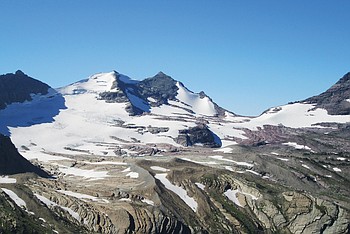Glaciers shrinking, but scientists still determining rate of melt
HEIDI DESCH | Hagadone News Network | UPDATED 6 years, 3 months AGO
Heidi Desch is features editor and covers Flathead County for the Daily Inter Lake. She previously served as managing editor of the Whitefish Pilot, spending 10 years at the newspaper and earning honors as best weekly newspaper in Montana. She was a reporter for the Hungry Horse News and has served as interim editor for The Western News and Bigfork Eagle. She is a graduate of the University of Montana. She can be reached at hdesch@dailyinterlake.com or 406-758-4421. | March 19, 2019 2:03 PM
Glaciers are melting as a result of climate change. However, how fast that will occur remains to be seen and will likely be impacted by how society reacts to climate change.
Erich Peitzsch, a physical scientist from the U.S. Geological Survey, says what’s driving the retreat of glaciers is an increase in temperature. He points to changes globally, but also locally for having impacts.
“Northwest Montana is seeing a 1.8 times greater temperature rise than global temperatures are increasing,” he said. “Upper elevations are warming faster than lower elevations.”
Peitzsch joined Jim Elser, Director of the Flathead Lake Biological Station, in opening the inaugural Montana Lakes Conference Wednesday night with a community talk on fading glaciers and the resulting impacts.
Elser scrolled through photos of glaciers in Glacier National Park comparing images taken decades apart that show how glaciers have shrunk over time. One photo of Grinell Glacier in Glacier Park taken in the 1920s shows a large boulder in the center of the photo surrounded by ice, while a photo taken in the same spot at the glacier in 2017 shows a field of green around that same boulder.
“In the Flathead, our waters start in ice and snow,” Elser said. “What’s happening with glaciers impacts what happens at the top of the watershed.”
Elser said the sooner the world can get to a place of zero carbon dioxide emissions the better to curb the impacts of climate change, including the loss of glaciers in the coming decades, and a list of environmental and economic issues that could come as a result.
“It’s not too late to avoid the worst outcomes,” he said. “The longer we wait the more difficult and costly it will be.”
In 2017 the USGS released a study that showed that the average area reduction for the 37 named glaciers in the Park was 39 percent.
Peitzsch said that the volume of ice lost to melting has exceeded the replenishment that comes through snowfall. Glaciers are “sensitive indicators of climate,” he notes, but scientists are still trying to find out more.
Peitzsch said what he and his colleagues are discovering is that cirque glaciers, ones that occupy a bowl-shaped basin at the head of a mountain valley, are reacting differently to climate change.
“We’re finding that local processes have more impact as a glacier retreats,” he said.
To answer the question of how much of a driver is the climate on cirque glaciers they looked at the relationship between Sperry Glacier’s ice loss and changes in temperature and precipitation.
As a glacier recedes into the shelter of the mountains more of it can become shaded, thus limiting the impacts of the sun on melting, and avalanches can actually cause snow to be added to the glacier, he noted of their findings. “Local processes are sustaining these glaciers longer than we thought,” he said.
“Local processes still might allow these glaciers to cling to the landscape in their basins for a little longer.”
Peitzsch isn’t pronouncing the complete melting of all glaciers, but he does note that they are changing.
“Glaciers are going to be around for awhile,” he said. “They’re not going to look like they did in the 20th century and in the future they won’t look like they do today, but they will be around.”
Peitzsch said that while these local processes play a bigger role to glaciers than previously thought, it doesn’t mean that climate is not a driver of them melting.
Elser hikes into the high country of Glacier Park to study the lakes and streams that result when a glacier retreats.
“When glaciers retreat that modifies the landscape,” Elser said.
While he says it’s exciting from a scientific perspective to test what are essentially new water bodies, the changes that result from the melting glaciers and loss of snow, along with climate change, can have impacts ecologically and economically.
The loss of habitat through the melting glaciers and increased stream temperature, he notes, have an impact on the aquatic insect the western glacier stonefly and native cold water fish.
The loss of culture that comes from the loss of winter recreations in the mountains. And the economic loss that comes as a result of decreased summer and winter recreation opportunities as a result of climate change are also present, he notes.
MORE FRONT-PAGE-SLIDER STORIES

The average reduction in Glacier's glaciers? 39 percent, study shows
Hungry Horse News | Updated 6 years, 3 months ago

Topography, snowfall affect retreat of cirque glaciers
Hungry Horse News | Updated 7 years, 9 months ago

Topography, snowfall affect retreat of cirque glaciers
Daily Inter-Lake | Updated 7 years, 9 months ago
ARTICLES BY HEIDI DESCH

Whitefish to decide on payday for mayor, city councilors
Following a public hearing, Whitefish City Council is set to vote on whether the mayor and city councilors should receive an annual salary and stipend for service.
County talks modest pay increases for staff
Seemingly striking a compromise, the Flathead County Compensation Board last week voted to recommend a 2.5% cost of living increase in county wages.

Flathead County seeks to expand landfill for future needs
Flathead County is looking to expand its landfill operations in the future, which is expected to allow it to accept waste for another eight decades beyond its current capacity.

